レポート
Introduction
Last year, Bain & Company published its second annual India Philanthropy Report, which continued to stimulate much public debate. Our 2011 report found a significant rise in private donations to philanthropic causes. The findings showed that such donations increased by 50% between 2006 and 2011, documenting a hopeful trend.
This year, we provide a deeper analysis of some of the newer trends that are contributing to this ongoing rise. To gain insight, we conducted our largest survey of India’s wealthy individuals to date, polling almost 400 high-net-worth individuals (HNWIs*) and emerging HNWIs in Delhi, Mumbai, Hyderabad and Pune. Participants described how much they give, how they give, what causes they support and their motivation for doing so.
One trend that stands out in their responses is the growing role of young people—donors under the age of 30—in Indian philanthropy. Within this fast-expanding HNWI class, there is an especially strong commitment to “giving back.” We believe that facilitating these young donors and their preferred methods of donating—as well as novice donors of all ages—is crucial to the continued growth of philanthropy in India.
Too many individuals have been excluded from India’s economic boom over the past decade—the country is simultaneously home to one of the world’s fastest-growing HNWI populations and one in three of the world’s malnourished children. We can not be comfortable with this striking imbalance.i
This year’s report focuses on three objectives:
- Provide an overview of trends spurring philanthropic growth
- Analyse two factors at the heart of current and future growth: the rise of young philanthropists, and a desire across philanthropists of all ages to invest in education
- Highlight hurdles to continued growth and outline potential solutions
1. Overview of current state
A growing number of Indian HNWIs have both the means and the inclination to participate in philanthropy. A year ago, our research showed that India was a leader in private charitable giving among developing nations, with donations totaling between 0.3% and 0.4% of GDP.
This year’s survey found that more than 70% of the donors were novices, with less than three years of philanthropic experience. More than a third of those surveyed were 30 years old or younger. Such data underscores the fact that Indian philanthropy is a nascent sector, with enormous room for growth and tremendous promise.
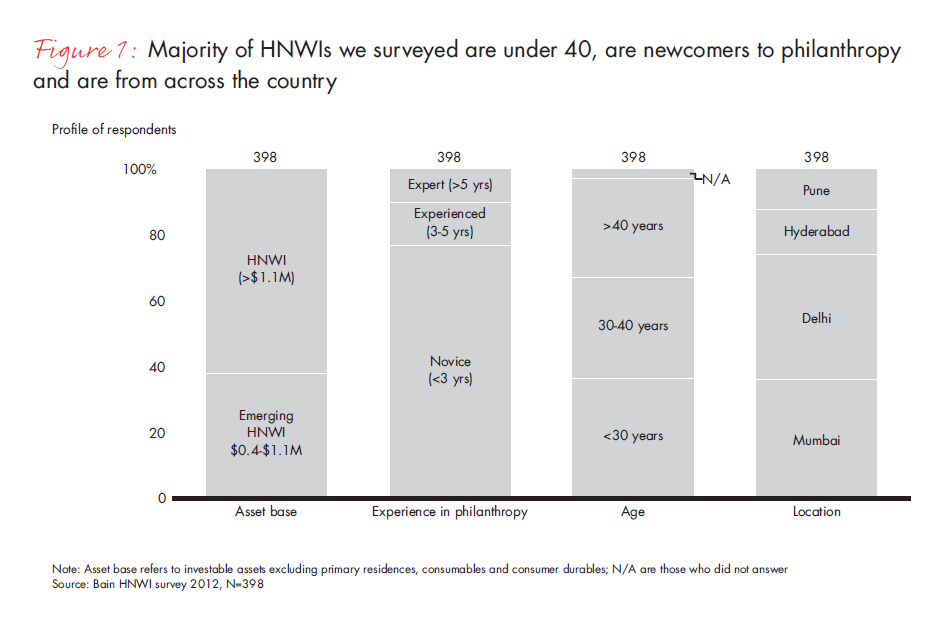
It is heartening to note that charitable giving has continued to rise over the last twelve months, with HNWIs donating an increasing proportion of their wealth to charitable causes. The average contribution was 3.1% of total income in 2011, up from 2.3% during the previous year.
More than half of HNWIs surveyed expect to boost their donations again this year, a finding we will explore in more detail later in this report. Although giving is on the rise, there is significant room for improvement if India is benchmarked against the US, one of the world’s leaders in private giving, where HNWIs donate 9.1% of their income on average to charity.ii
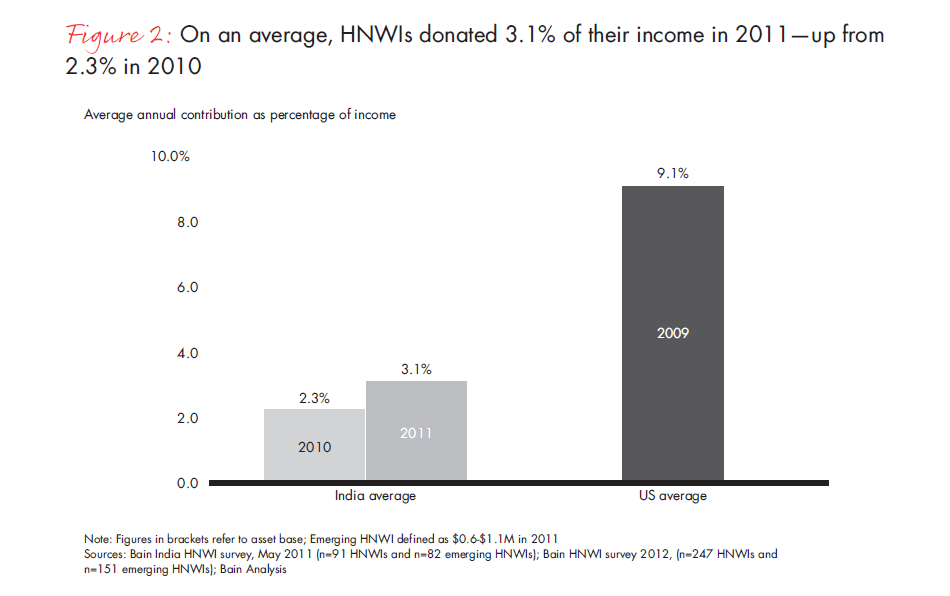
When compared with US donors, India’s HNWIs are newcomers to philanthropy. Nearly 80% of the HNWIs in our study view themselves as novice donors while 74% of their counterparts in the US consider themselves experienced. This has profound implications for the work that nonprofits and others in the field must undertake to win the confidence and raise the awareness of potential philanthropists in India.
This country is also home to one of the fastest-growing HNWI populations in the world. The latest data shows that the demographic group grew by 21% in India between 2009 and 2010, compared with just 12% in China, 8% in the US and 6% in Brazil.iii
When we consider both the inexperienced status of existing affluent givers and the emergence of ever more potential givers, the combined forces are likely to drive the continued growth of Indian philanthropy. However, this growth is contingent on organisations demonstrating impact and raising confidence in the returns on giving.
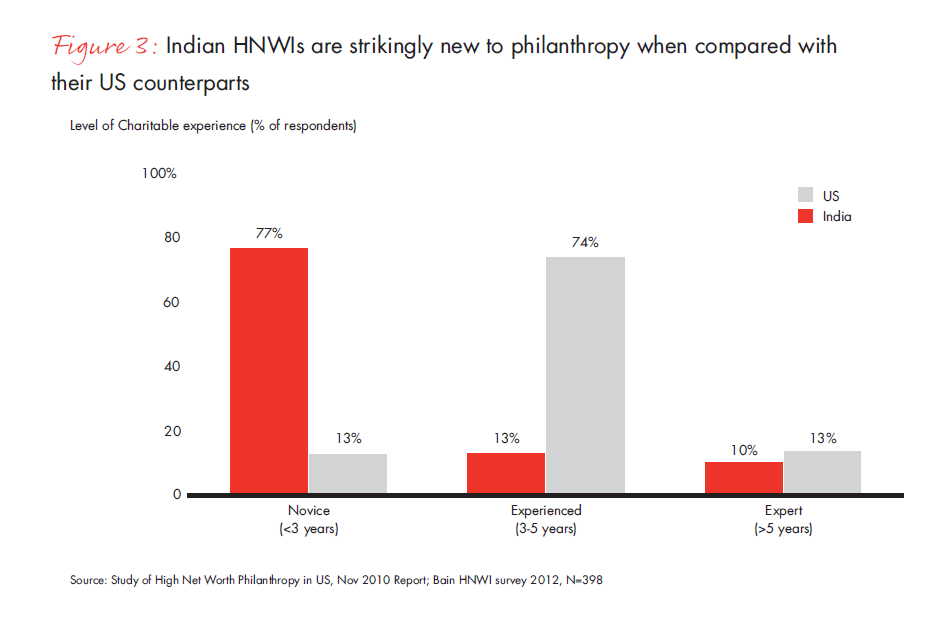
Although NGOs and grassroots organisations remain top recipients of donations across all causes, private foundations have experienced an increase in donations over the last year. With the rise of prominent avenues for giving such as the Azim Premji Foundation and the Shiv Nadar Foundation, the model for private foundations in India is gaining traction.iv This trend is similar to the important role they play in the US.
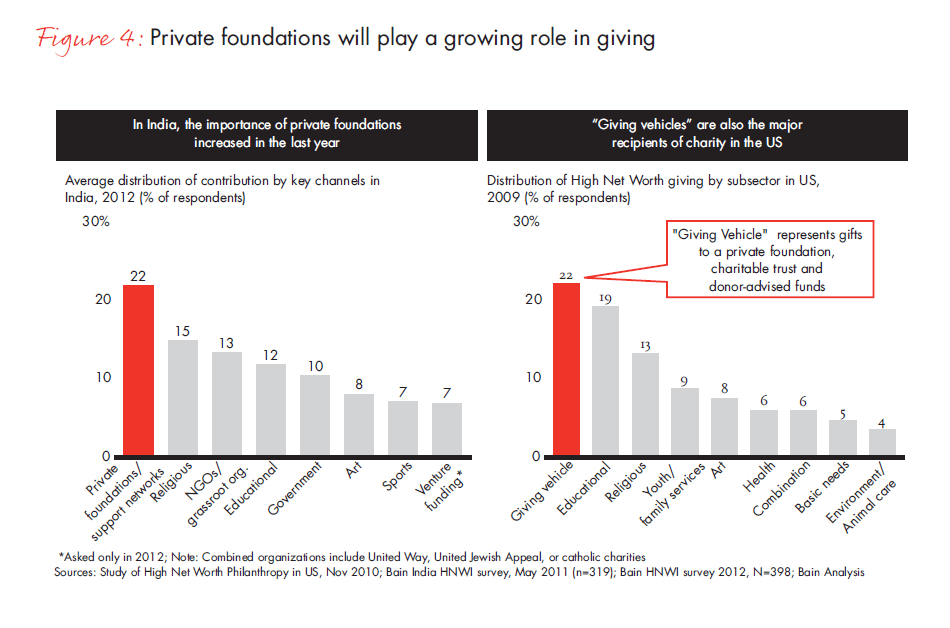
2. Young philanthropists rally to the cause
Wealthy young Indians appear particularly interested in increasing their philanthropic involvement and represent an important opportunity for future growth. Some of these young individuals already are part of an established community of givers—they often are entrepreneurs’ sons and daughters who are taking the helm of the family business. Others are part of a new wave—they are senior executives at Indian and multinational firms or self-made entrepreneurs who have benefited from India’s economic boom.
These “next-generation” donors show greater interest in making donations through formal channels to established NGOs, rather than giving money to a local religious institution or setting up their own informal projects as their parents may have done. Many next-generation donors have been educated overseas and want to adopt Western practices that favor more structured ways of giving, with a focus on outcomes, according to Indian philanthropy experts. At the same time, they want to make those practices relevant to India’s existing strong culture of giving.
As a result, young Indian philanthropists are playing a key—and outspoken—role in their family’s charitable activities. Among families who participate in philanthropy, 76% have younger relatives who have assumed an active role in choosing charities, while 69% say young members shape or spearhead the family’s charitable mission. Our findings show the importance of younger family members in the rise of philanthropy. India must consider the voice of youth in its efforts to cultivate giving.
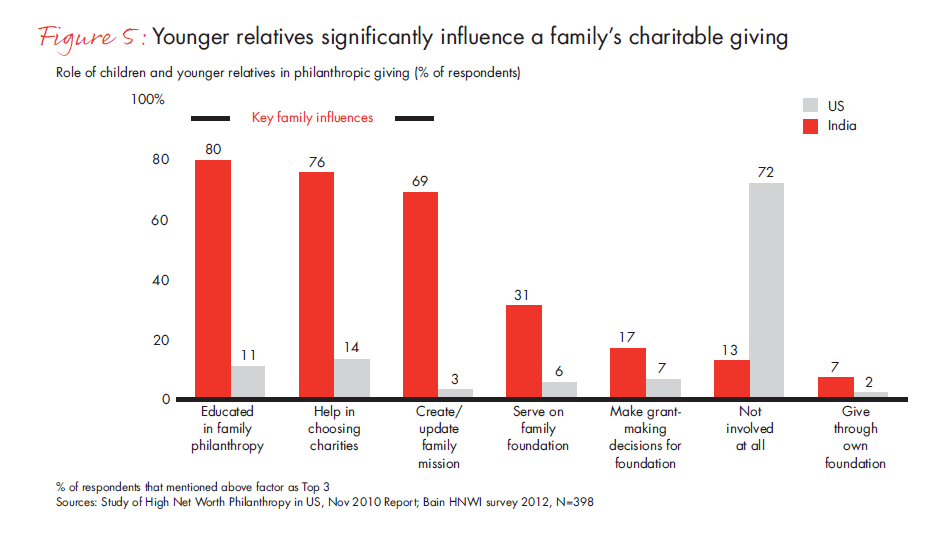
While young philanthropists donate a smaller proportion of their own income to charitable causes, they are more likely than other age groups to increase their donations in the coming years. That positions them at the forefront of future growth.
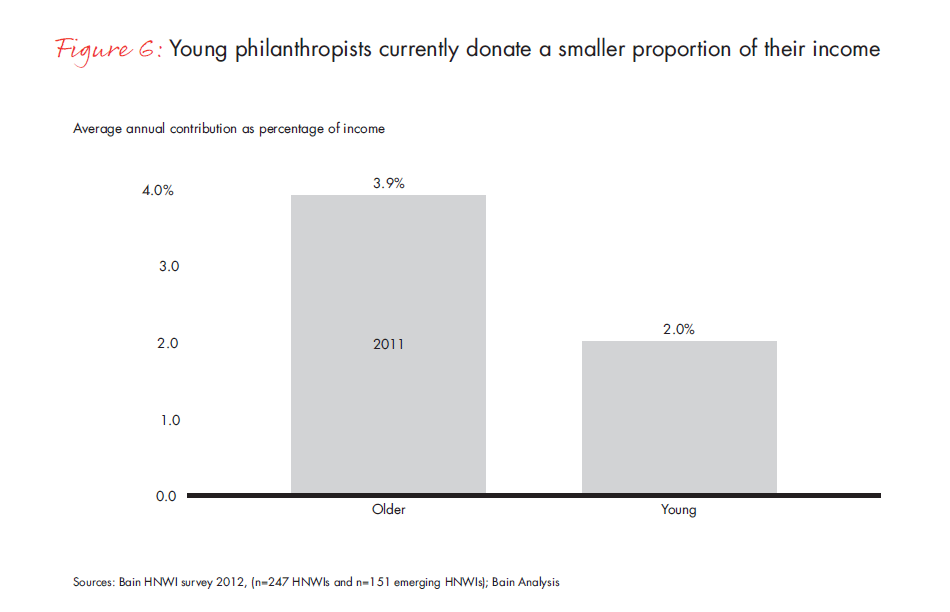
As their careers progress and their assets grow, young donors are committed to giving more. Our research shows that 57% of young philanthropists expect to increase their charitable contributions in 2012, compared with 49% of those over the age of 30. They also are slightly more interested in making larger donations over the next five years.
In addition, young HNWIs have a notable interest in venture philanthropy. This model—similar to the Dasra Giving Circles—involves not only contributing financially to a nonprofit but also sustaining that investment and setting targets for the chosen organisation over several years. The aim is to build capabilities for the nonprofit to significantly enhance outcomes.
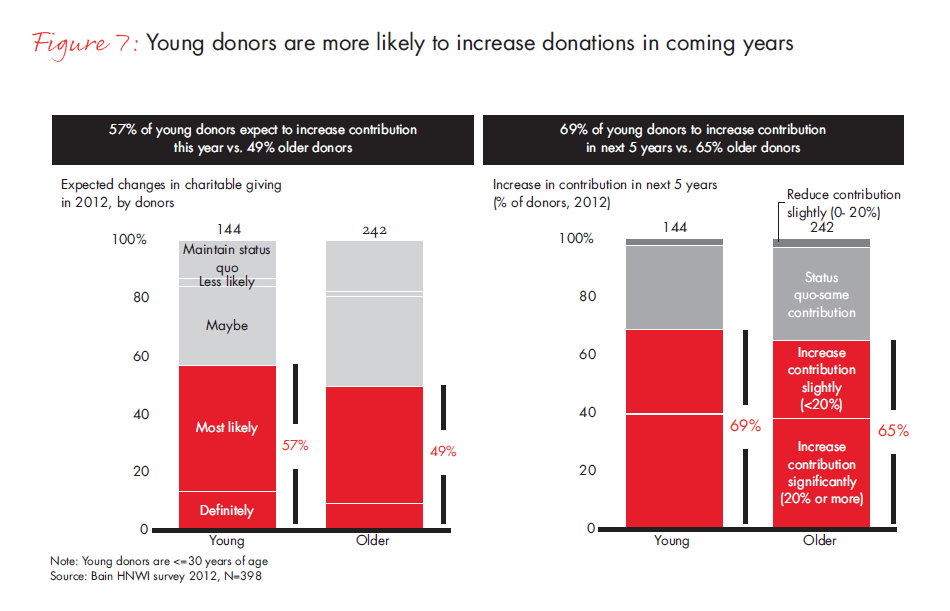
Across all age groups, charitable projects that address basic needs are the most popular with donors, in line with our research from last year. Education remained the top charitable cause but there was also a large jump in support of food and clothing projects.
Philanthropy has a tremendously important role to play as India struggles to lift hundreds of millions of people out of poverty. Prime Minister Manmohan Singh recently called the country’s high child malnutrition rates a national shame, after a coalition of NGOs issued a report showing that 42% of Indian children under the age of five were underweight.v
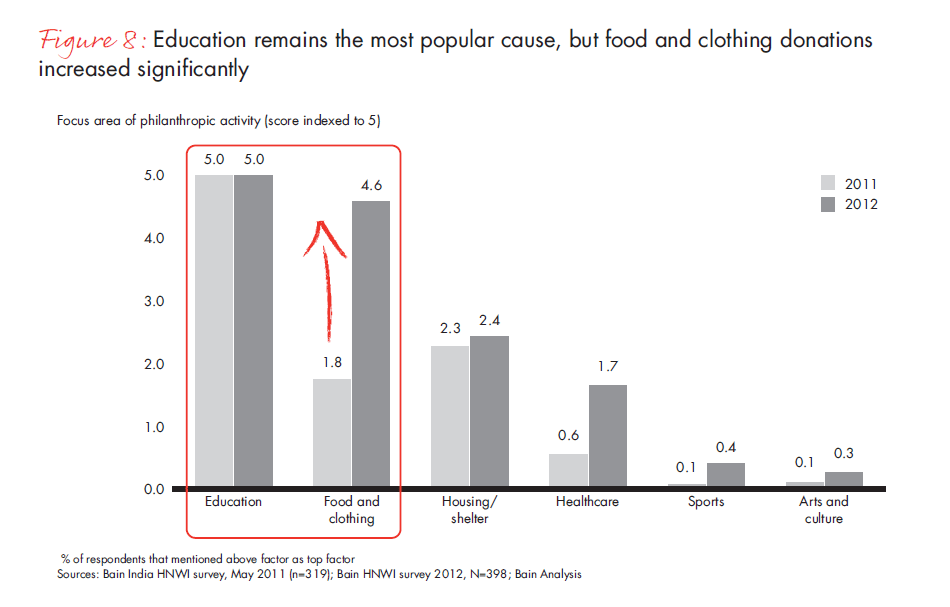
Education is not only a major interest of HNWIs—it is also the focus of several topics at the 2012 Indian Philanthropy Forum.
3. NGOs that work on education can have a major impact
Education projects continue to be the leading recipients of charitable donations in India. The country’s bleak statistics on education levels, particularly among the hundreds of millions of Indians living below the poverty line, show that this is an urgent concern:vi
- 20% of India’s poor have no access to education
- 86% have no access to technical and vocational training
- 45% drop out of school before eighth grade
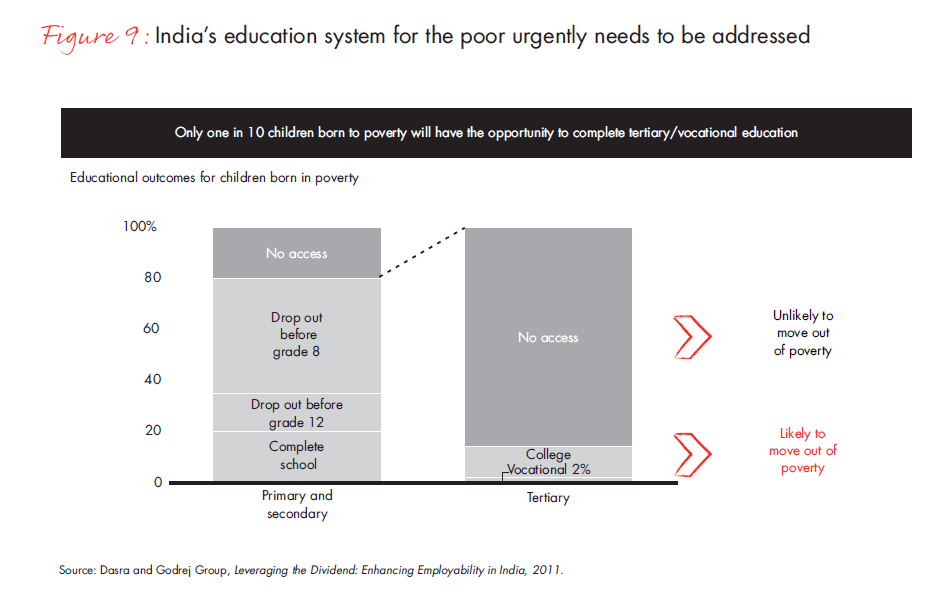
An educated and skilled workforce is critical for India’s continued economic growth, with services such as outsourcing playing a key role in the economy’s expansion. The country’s working-age population is expected to increase by 47 million by 2020. If these workers are properly trained, India could establish itself as a global hub of human resources. Some estimates suggest that creating a more employable workforce also could reduce poverty by as much as 70% and increase per capita income from $1,212 to $4,100 by 2025.vi
As W.B. Yeats, the Irish poet, said: “Education is not the filling of a pail but the lighting of a fire.” India needs the fire of an educated population of young people to move the nation forward.
In order to illustrate the major impact that NGOs can have on education, thereby contributing to the government’s efforts in this area, we looked at a wide range of NGOS that work across different aspects of the education system. The groups range from those that provide primary education and free schoolbooks, to those that coordinate vocational training and influence policy.
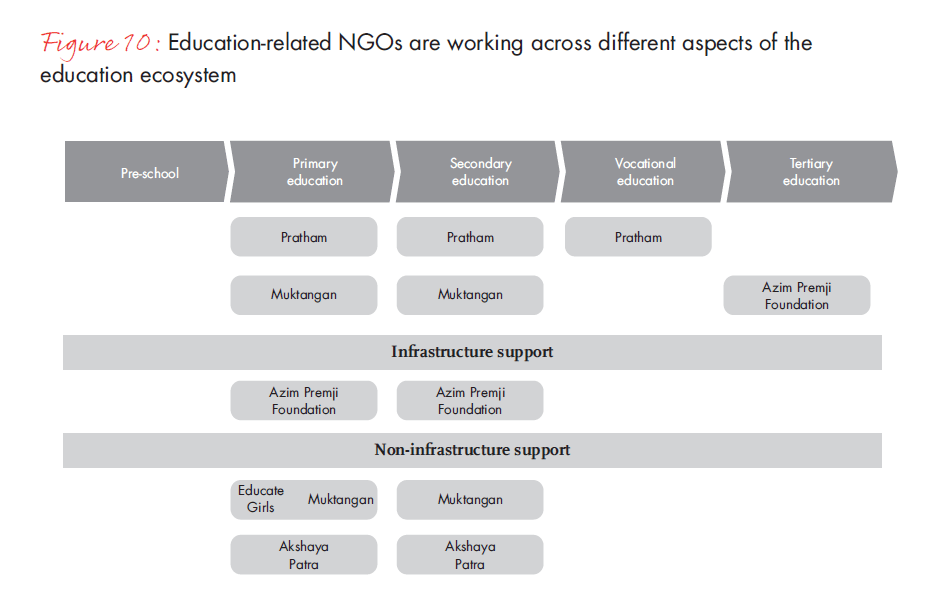
The following case studies explore how these different types of education-related NGOs are having a significant impact on their focus area.
Pratham
Pratham is widely held to be India’s largest NGO in the education sector, in terms of the number of children assisted. Read India, its flagship program, aims to improve basic literacy and the mathematical abilities of underprivileged children. In 2011, Read India worked with nearly 2.4 million children and trained more than 60,000 teachers. Pratham’s work is fundamentally changing education in India.vii
Azim Premji
The Azim Premji Foundation, established in 2001, works with state governments to reform teaching and testing methods in government schools. Following the charity’s efforts to promote examination systems that go beyond testing rote learning, at least eight districts in five states reformed their examinations. The Azim Premji Foundation also has provided 20,000 schools across 16 states with syllabus-based multimedia kits that promote computer-assisted learning.viii
Akshaya Patra
Akshaya Patra is a large NGO with one goal: to provide children with a meal at school. The charity launched its first program in Bangalore in 2000 and today feeds lunch to 1.3 million children daily across the country. This simple initiative addresses two major issues: It boosts school attendance and tackles malnutrition. Akshaya Patra works with eight state governments to implement its school lunch program and has inspired other NGOS to launch similar efforts.
Muktangan
Muktangan demonstrates how smaller scale NGOs also can have a significant impact on their chosen community or city. This project draws women from low-income communities in Mumbai and trains them as English-medium teachers. Since its founding in 2003, Muktangan has trained 180 teachers. Following a successful pilot, the Municipal Corporation of Greater Mumbai asked Muktangan to take on an additional role and run seven of its schools. The charity is currently responsible for 1,800 students in Mumbai.ix
Educate Girls
Educate Girls strives to tackle gender inequality in schools in Rajasthan. The literacy rate among women in the state is just 53%, compared with 81% among men. Educate Girls’ first project in 2008 spanned more than 200 villages in Rajasthan’s Pali district. Two years later, female students’ school attendance in these areas had risen dramatically, from 67% to 82%. Rajasthan’s state government has since invited Educate Girls to work across Pali as well as the Jalore district.x
These are powerful examples of how NGOs are working to improve education in India. With their discipline and vision, coupled with the backing of generous donors, NGOs have the ability to change the course of education in our country.
4. Looking Ahead: Projections for future growth and how to achieve it
We expect the level of Indian philanthropy to continue to increase in both the near and medium term, as more HNWIs learn about and participate in charitable giving and as novice donors gain confidence. Although obstacles to growth remain, we are pleased to note that donors’ concerns are gradually waning.
Our research shows that 52% of HNWIs plan to increase their charitable contributions in 2012, with a significant portion of this group expecting to boost their donations by 10% or more.
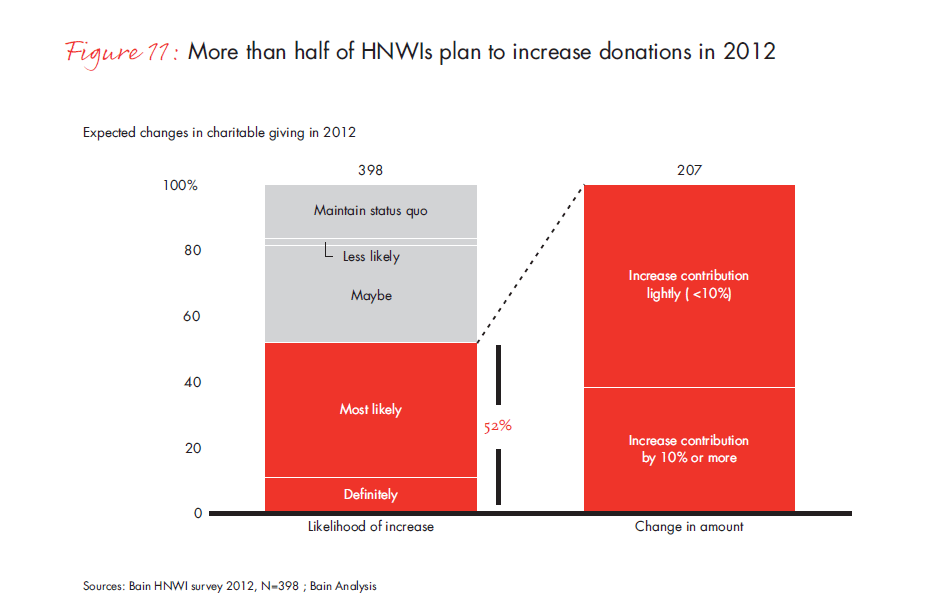
We also found that a growing number of HNWIs plan to give more in the medium term—66% say they will increase contributions over the next five years, a significant jump in just a year. More than a third of those surveyed expect to raise their donations by at least 20%.
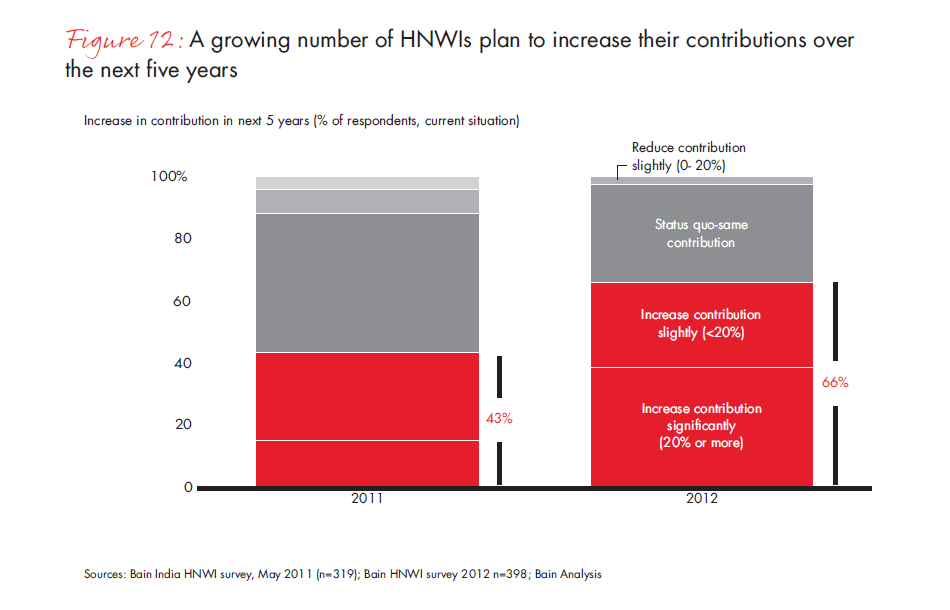
Obstacles and Solutions
In order to reach India’s full potential for private charitable giving, it is important to continue addressing the concerns of both donors and philanthropy experts. All participants—donors, intermediaries, recipients and regulators—must take action on these issues.
Philanthropists cite a lack of accountability as the biggest obstacle to giving, consistent with last year. Many HNWIs feel that there is a lack of easily available financial information about charitable organisations, leading to concerns about both inefficiency and misuse of their money. For new donors to increase their contributions, the need for improved accountability and financial transparency must be addressed.
However, we are encouraged to see a drop in the number of philanthropists who cite this issue—53% say a lack of accountability prevents them from giving more, compared with 70% last year.
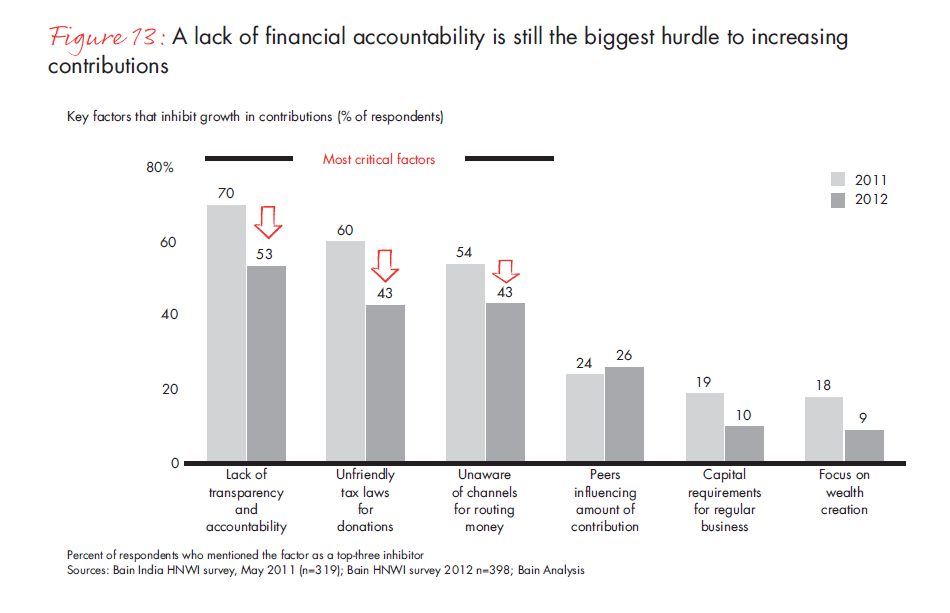
A lack of awareness of different models for charitable giving poses another major obstacle. In India’s relatively nascent philanthropy sector, existing and potential donors often do not have enough exposure to the options for giving, ranging from direct donations to NGOs, to foundations and venture philanthropy schemes. As a result, some contributors struggle to find a model that suits them. The sector needs more professional intermediaries, such as consultants or networking groups like Dasra or GiveIndia, that can guide each donor to the channel that best fits their interests and needs.
Once again, we’ve seen a decline in the level of concern among HNWIs on lack of awareness of channels, from 54% last year to 43% this year.
Since launching our groundbreaking India Philanthropy Report in 2010, the first major report on this sector by any company, Bain has charted the growth of structured private giving in India. This year, we are encouraged by the emergence of the next generation of donors, who are even more committed to supporting this charitable culture as their wealth grows.
India’s community of philanthropists—charitable givers and those with the potential to give—must strive to build a more fully-developed philanthropy “ecosystem,” one that provides more sources of information and advice, transparency initiatives and supportive regulations. There is also a dire need for more professional and well-trained staff members at NGOs, with the ability to deliver improved results in the field, put donations to effective use and, most critically, track results.
Our most affluent individuals have a strong desire to donate a portion of their wealth to the hundreds of millions of Indians who lack even the most basic services. We are only a few steps away from better supporting that need.
Arpan Sheth is a partner with Bain & Company, Mumbai office. He leads the Private Equity and Mergers and Acquisitions practices for Bain & Company in India.
*HNWIs are defined as those with investible assets of more than $1.1 M (assets excluding primary residence, consumables and collectibles). Emerging HNWIs are defined as those with assets of between $0.4 M and $1.1 M.
References
i Unicef, “Picture in India: Nutrition,” accessed March 7, 2012, www.unicef.org/india/children_2356.htm. See also Unicef, The State of the World’s Children 2011, www.unicef.org/sowc2011/fullreport.php.
ii Bank of America Merrill Lynch and the Center on Philanthropy at Indiana University, 2010 Study of High Net Worth Philanthropy, 2010.
iii Capgemini and Merrill Lynch Global Wealth Management, World Wealth Report 2011, June 2011.
iv Azim Premji Foundation, www.azimpremjifoundation.org, Shiv Nadar Foundation, www.shivnadarfoundation.org.
v Hungama Survey Report, 2011, http://hungamaforchange.org/HungamaBKDec11LR.pdf. See also ”India ‘shamed’ by child malnutrition, says PM Singh,”BBC, January 10, 2012, accessed March 7, 2012, www.bbc.co.uk/news/world-asia-india-16481731.
vi Dasra and Godrej Group, Leveraging the Dividend: Enhancing Employability in India, 2011, http://dasra.org/pdf/LTD-small-compositve1.pdf.
vii Pratham, www.pratham.org.
viii Akshaya Patra, www.akshayapatra.org.
ix Muktangan, http://muktanganedu.org.
x Educate Girls, http://educategirls.in. See also Indian Census, 2011, provisional results, accessed March 9, 2012, http://censusindia.gov.in/2011-provresults/ prov_data_products__rajasthan.html.
This work is based on secondary market research, analysis of financial information available or provided to Bain & Company, and a range of interviews with industry participants. Bain & Company has not independently verified any such information provided or available to Bain and makes no representation or warranty, express or implied, that such information is accurate or complete. Projected market and financial information, analyses and conclusions contained herein are based on the information described above and on Bain & Company’s judgment, and should not be construed as definitive forecasts or guarantees of future performance or results. The information and analysis herein does not constitute advice of any kind, is not intended to be used for investment purposes, and neither Bain & Company nor any of its subsidiaries or their respective officers, directors, shareholders, employees or agents accept any responsibility or liability with respect to the use of or reliance on any information or analysis contained in this document. This work is copyright Bain & Company and may not be published, transmitted, broadcast, copied, reproduced or reprinted in whole or in part without the explicit written permission of Bain & Company.